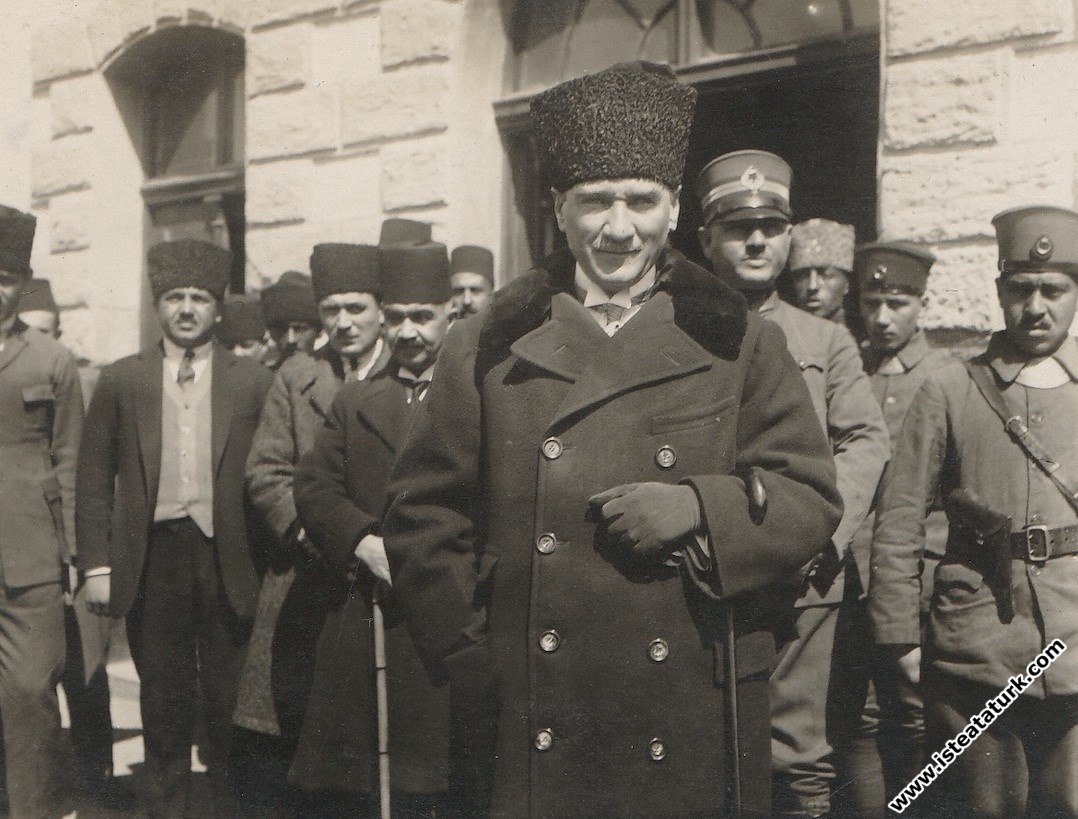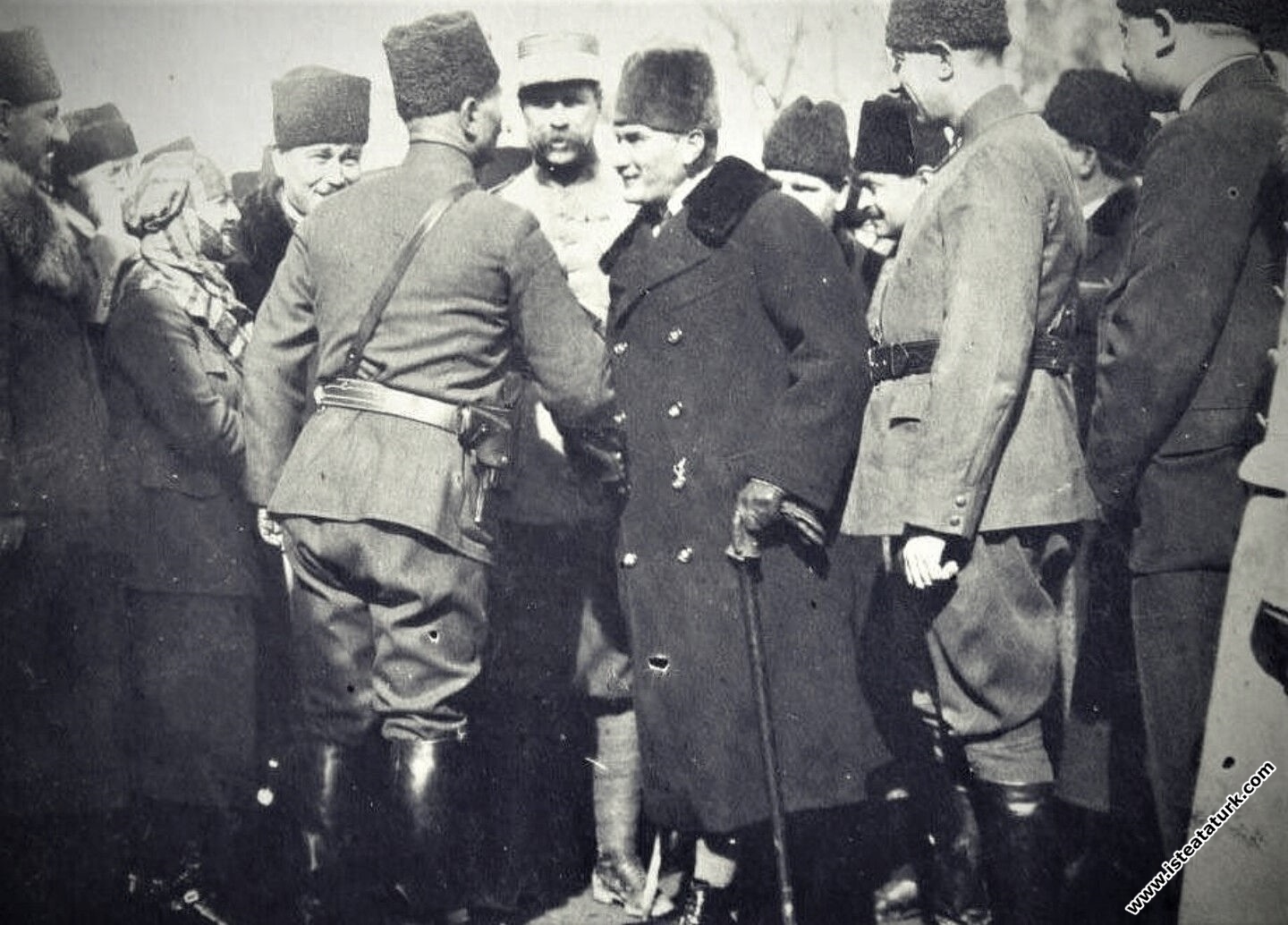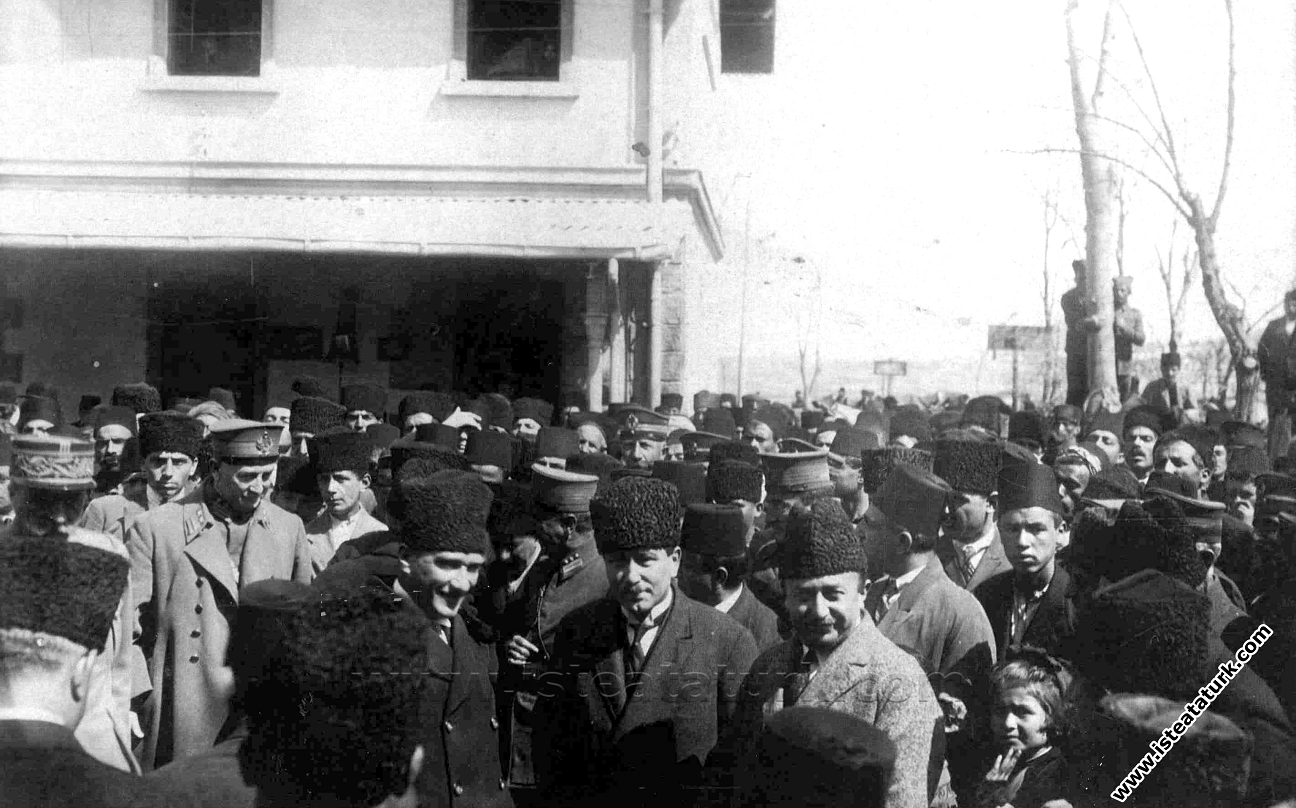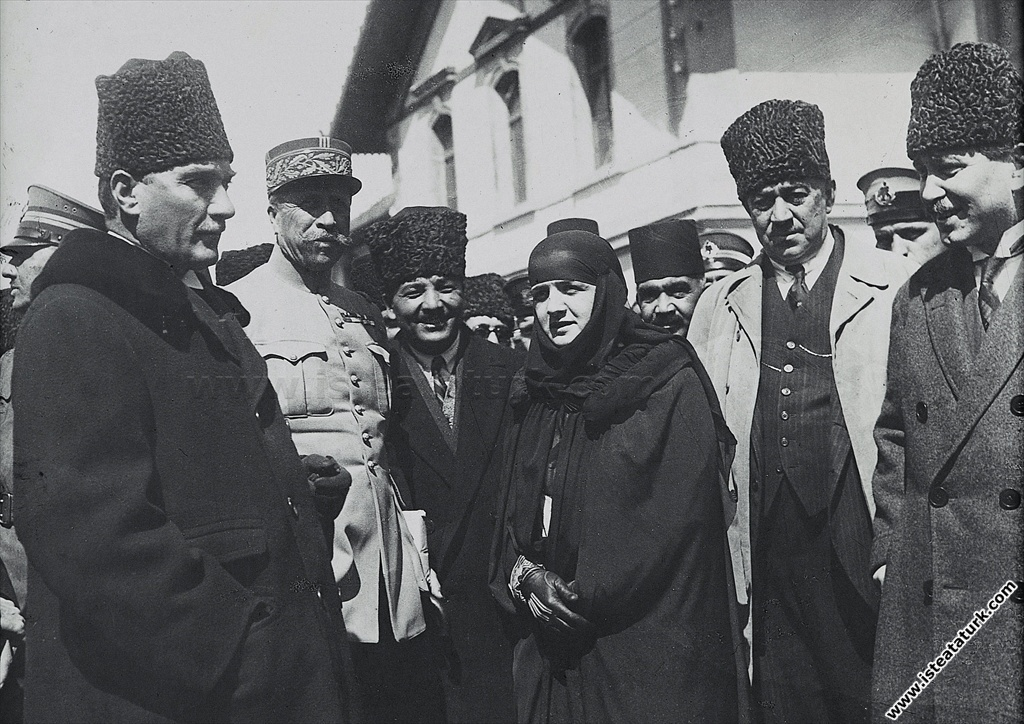Mustafa Kemal Atatürk, on his way to Ankara Station to bid farewell to Fethi Okyar, who went to Paris as an ambassador. (27.03.1925)
| Photo source: Atatürk Gazi Mustafa Kemal, Photo by Cemal Işıksel, Turkish Historical Society Press, Ankara, 1969. Page: 9 |
| Photographer: Cemal Işıksel |
Mustafa Kemal Atatürk, on his way to Ankara Station to bid farewell to Fethi Okyar, who went to Paris as an ambassador. (27 March 1925)
A Memoir of Cemal Işıksel
“It was the last days of March 1925. Fethi Okyar was going to Paris as Ambassador. Atatürk came to the station to bid farewell. I was waiting with my machine set on the coffee table. I was greeted at the door as I entered the platform from the station building.
I said , "Wait a minute, Pasha . "
" Well , boy, hurry up," he said.
In May 1933, on the anniversary of the farm, I was taking pictures of Atatürk again. He turned to me with a smile,
"You couldn't pull it off that easily the first time, did you, kid?" he said.
He stunned me by remembering how I worked at the station eight years ago.
That was Atatürk.
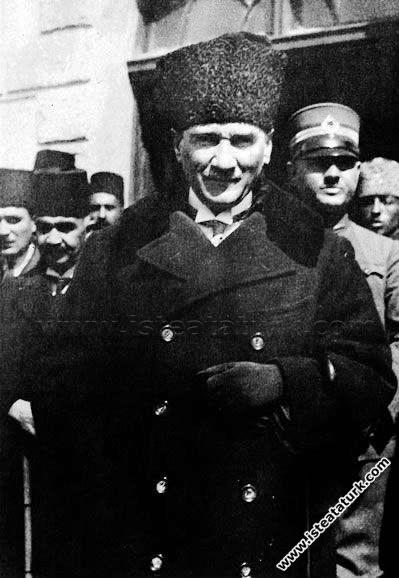
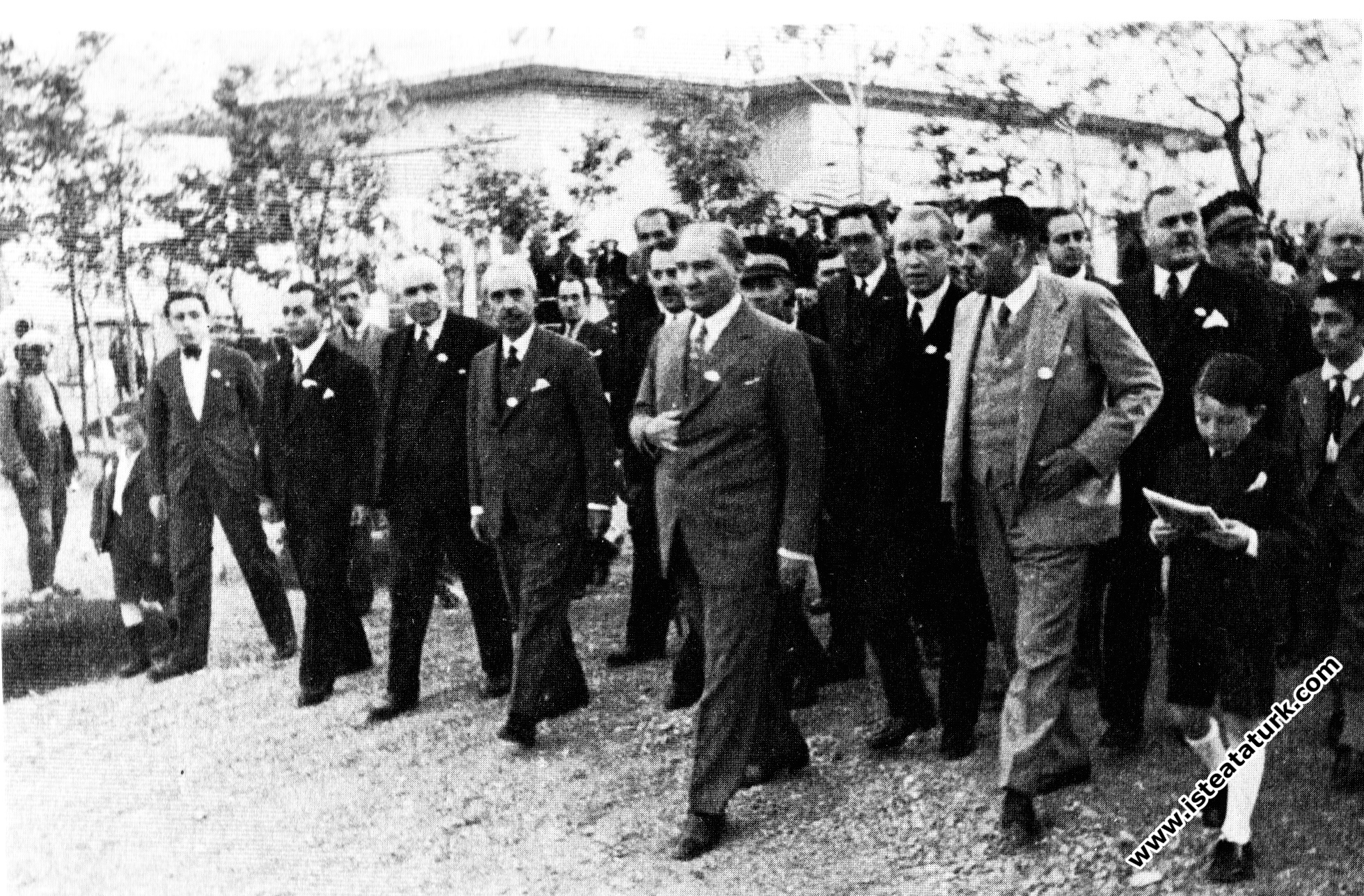
On the way to the anniversary celebrations of Atatürk Gazi Forest Farm. (25 May 1933)
CEMAL ISIKSEL "LIFE"
Cemal Işıksel, one of the first photojournalists of the Republic of Turkey, was born in 1904 in the Vefa district of Istanbul.
His father is Hasan Fehmi Efendi from Nevşehir, a member of the high religious council (Order Prof.) who wrote the fatwa prepared against the Istanbul Government in Ankara in April 1920. He completed his primary education in Istanbul and Eskişehir. Işıksel, who immigrated to Ankara in 1919 due to his father's civil service, completed his secondary, high school and higher education in Ankara. Cemal Işıksel, who started photography as an amateur when he was a high school student with the encouragement of his father by gifting him his first camera during his high school years, is one of the first graduates of Ankara Law Faculty.
Upon the suggestion of Hakkı Tarık Us, he started to work at Vakit Newspaper. He took Atatürk's photograph for the first time in 1924 at Ankara Train Station while he was on his way to Afyon to attend the second celebration ceremonies of the Dumlupınar Victory. He never forgot this moment and later recounted it with the following sentences:
“He never forgot my rush the day I took my first photo. He hadn't forgotten my second rush either. The second time he saw me in front of him, he reminded me of that day.”
He later became Ankara photojournalist for Vakit Newspaper in early 1925. For those days, this was novelty. Cemal Işıksel is the number one photojournalist of the Ankara press. In the autumn of 1926, with the suggestion of Yunus Nadi, he was transferred to the Cumhuriyet Newspaper. After working for the newspapers Hakimiyet, Milliyet and Ulus between 1929 and 1944, he re-entered the Republic.
He participated in Atatürk's domestic trips. In his 38 years of professional life, Işıksel took photographs of many foreign statesmen who came to visit our country, as well as the great statesmen of our Republican history, and prepared albums for them about their trips. Among them; Iranian Shah Reza Shah Pahlavi, Iraqi King Faisal, Afghan King Amanullah Khan, Jordan Melik Abdullah, Japanese Crown Prince Hirohito, Swedish Crown Prince Gustav, British Prime Minister Winston Churchill, Greek Prime Minister Venizelos, Soviet Russian Deputy Foreign Minister Karahan, and Defense Minister Voroshilov, Hungarian Prime Minister Count Bentlen was also present.
While Ercüment Ekrem Talu was the general manager of the press in 1926-27, his photographs showing the events of Atatürk and developments in Ankara were distributed to the world press.
Işıksel's photographs were on the cover of European magazines. He used to send photographs to Sedat Simavi's Yedigün Magazine every week. His photographs were published in the illustrated magazine of the Ministry of National Education and in textbooks. He photographed the Great Leader Atatürk from 1925 to 1938, and İsmet İnönü during his presidency, with great love and enthusiasm, and photographed the transfer of Atatürk's body to Anıtkabir in 1953. He ended his photojournalism, which he continued actively until 1956, in 1963. He was given a press honor card in 1956 and a certificate of honor by the DGSA photography institute in 1982. On November 10, 1965, he opened the first "Atatürk photographs" exhibition in the hall of the German Cultural Center in Ankara. İsmet İnönü, who visited this exhibition, wrote the following sentences in the exhibition book:
“We lived together with the Great Atatürk from 1925 to 1938… We owe our thanks and gratitude to our esteemed exhibition owner, Cemal Işıksel, for giving us this invaluable opportunity. The period from 1925 to 1938 is the foundation of Turkey on new foundations. Victory and the life of ideals…” İsmet İnönü 15.11.1965
He created a permanent Atatürk exhibition on the first floor of the apartment on Atatürk Boulevard until 1975, when he had a heart attack. He presented this exhibition to our people in cities such as Samsun, Tarsus and Adana, as he repeated at various times by adding unseen and unknown photographs of Ata each time. The following sentences were included in the announcement letter of the 22nd Exhibition, which also includes a photograph of Atatürk and himself on the Aegean Ferry off the Trabzon Port:
“With these works that he has been continuing for seventeen years, he has organized 21 exhibitions in different provinces, districts, primary, secondary schools, universities and charitable associations. There are no sales or orders in his exhibitions as a principle… Entry is free, and he does not accept any fee for his labor and photographs from the place where the exhibition is prepared… He demonstrates these works to the mind-boggling sacrifices and creativity of the great man for our country, as well as to the trust and creativity he showed himself. He is doing this in order to be able to pay his debt of gratitude and gratitude for the interest by his own means…”
16 photographs and three-size Atatürk posters in envelopes, which he prepared for schools, attracted attention across the country as well as in official offices. He also has photographs printed on money and stamps.
After leaving the press life, Cemal Işıksel started to work on transferring the history of the Republic to the younger generations. For this purpose, he compiled his information and memories with examples from the rich collection of photographs he took. First, he published some examples of Atatürk's life, which he photographed from 1925 to 1938, as a chronological book of Atatürk photographs in 1969. Cemal Işıksel expresses the striking power of photography in his introduction to his album, which consists of four sentences:
“A lot has been written about Atatürk, a lot has been told. I bring you what my lens sees. I believe that these will allow history and future generations to get to know him better. Because here He will tell himself” Ankara, 26.12.1965.
Cihad Baban (Cumhuriyet, June 25, 1970), Adviye Fenik (Son Havadis, May 2, 1970), Burhan Felek (Milliyet, October 15, 1970), Falih Rıfkı Atay (World, December 21, 1969) Admiring the Atatürk photo album published by Cemal Işıksel in his articles they did.
He started to work on a second chronological book, which he started in the 1940s, consisting entirely of his own photographs. For this, he compiled the necessary photographs and information that he did not have, and made researches.
In addition to these books, he also made preliminary studies of the books “Ismet İnönü in Photographs”, which covers the life and works of İsmet İnönü, from his own collection, and “The history of Ankara with photos” and “Atatürk portraits”, which describe the foundation and development years of Ankara.
In an interview with him and Seyit Ali Ak:
“Yes, photography has a value and a historical value. I shot the Ankara landscapes that I shot after 1924 from a certain point and at very different times in order to emphasize the development. Today I have 1924, 1933 and 1973 comparisons of the same places. If we see an Ankara photograph with its historical development, its current state makes a sense. I have applied this method to different subjects. I have towed vehicles since 1923. Besides, I have studies showing the development of agriculture and factories.” he was saying.
Işıksel, who was careful not to sell Atatürk photographs throughout his life, passed away on September 9, 1989, when these books were in the preliminary study phase and he was about to finish the second Atatürk book. He was married and had two children.
Source: 1- Erken Cumhuriyet Dönemi Türk Fotoğrafı,1923-1960, Seyit Ali Ak, Remzi Kitabevi, 1. Basım,Nisan 2001 ISBN:975-14-0784-2.
2- www.fotografmag.com
